The Classical Period of Greek Art Began Around

Ancient Greek fine art and culture accept become cornerstones of modern western society. Information technology remains present in popular culture and one tin can come across its reiterations on film, fine art, architecture, and literature. However, throughout ancient Greek civilisation fine art underwent several singled-out changes in medium, style, use, and accessibility. Here, we examine these changes through fourth dimension.

Following the dissolution of the Mycenaean civilization and end of the Bronze Age in the 11th century BC, Greek civilisation roughshod into a period of relatively picayune social or artistic progression known every bit the Greek Nighttime Ages. The Geometric Period in Ancient Greece marked the end of this Dark Age, showtime with the re-emergence of ceramic painting during the Proto-Geometric Period (ca. 1050-900 B.C.).
The Geometric Period is characterized by its use of geometric patterns and shapes in its iconography. The focus of the art also shifted from the more fluid, amorphous shapes of the Mycenaean period and onto more recognizable depictions of the people and animals of the Athenian polis. The flow tin be split into three eras: the Early Geometric, Middle Geometric, and Late Geometric.

During this period of Ancient Greek art, there were ii prominent types of monumental votive vessels: kraters and amphorae. Kraters were used to decorate male person graves, where amphorae decorated female person graves. They generally had a slim neck and a widened center with two side handles.
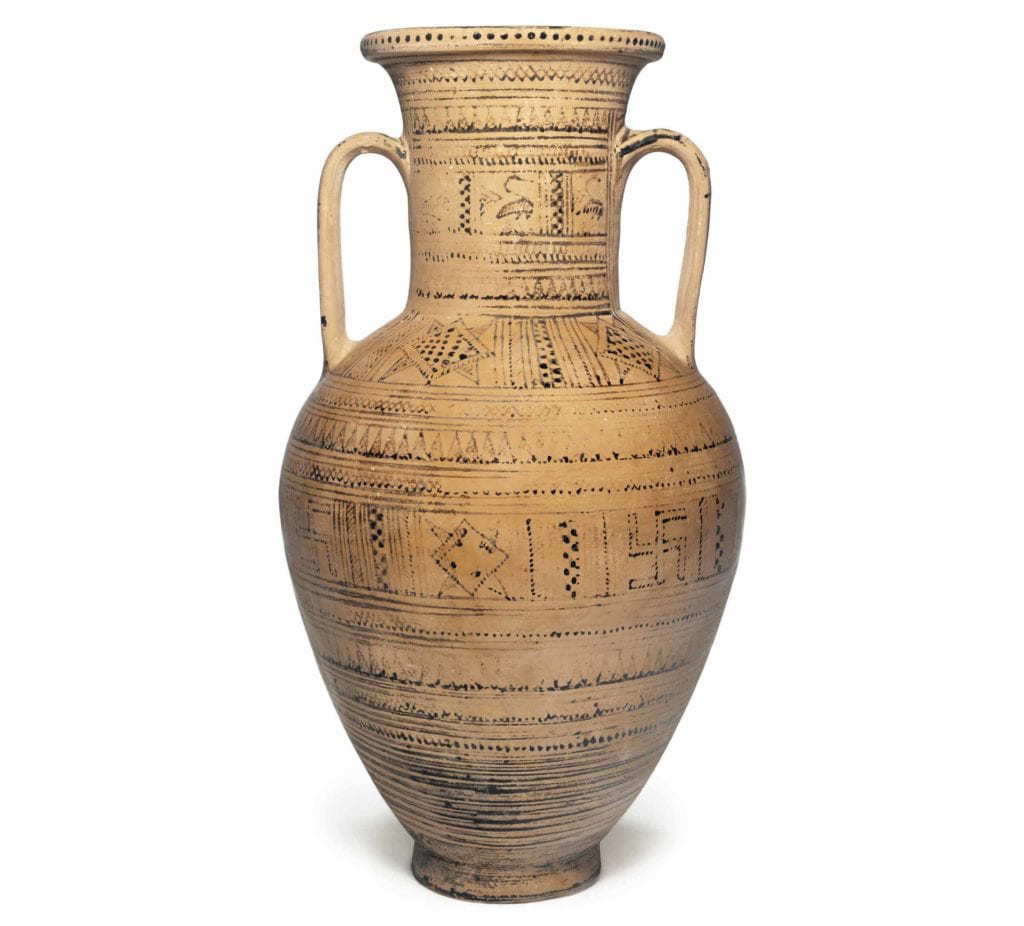
1 of the defining features of Geometric Menstruum pottery is called 'horror vacui', or the 'fear of empty infinite'. This manifested in filling entire surfaces with intricate details or patterns. Vases, for the well-nigh function, were thus completely covered with iconography, resulting in rich and artistic ornament.

Vessel decoration was often split into levels, which were then also decorated with processional or 'marching' scenes. Figures on Geometric Flow pottery were oftentimes painted in black against a lighter groundwork, and could be distinguished by their modest heads, widened triangular chests, small waists and angular legs.

Are you enjoying this article?
Sign upward to our Free Weekly Newsletter
Please check your inbox to activate your subscription
Give thanks you!
Though the Geometric Period is known primarily for its pottery, the Late Geometric period also developed a recognizable style of sculpture. These primarily bronze figures were mostly very simplistic, classically rendered, and elegant in form.
Archaic Period, ca. 700-480 B.C.

The Archaic Menstruation featured a considerable increase in interaction between the Greek world and the surrounding areas of the Mediterranean due to trade and international communication. This manifested itself through artistic and cultural influence from Egypt, the Near East, and other areas surrounding Greece.
The fine art of Archaic Flow Greece reflects this heightened international influence in technique, tools, and iconography. With continuously advancing technologies, artists were able to create realistic man imagery for the first time. They were too able to produce ornately detailed, colorful pottery.

Ii defining pottery styles emerged during Ancient Greece's Archaic Period. The starting time of these is known as black-figure pottery, which was made from red pottery with back coat decoration. The second pottery technique was chosen blood-red-effigy, which featured the outlining of figures in blackness, leaving them red on the within. Initially, these vessels were decorated with mainly war scenes, specifically from the Iliad or Odyssey. Notwithstanding, every bit time went on they also evolved into calmer scenes such as symposia or mythical storylines.
About prominently produced were drinking vessels. However, there were many methods used to produce them and they varied considerably in shape, use and size. Some were used for wine jugs, mixing or serving bowls, perfume jars, and storage jars. The shape of the vessel unremarkably indicated its utilize, only the vast majority of them featured a long neck, widened center and side handles.
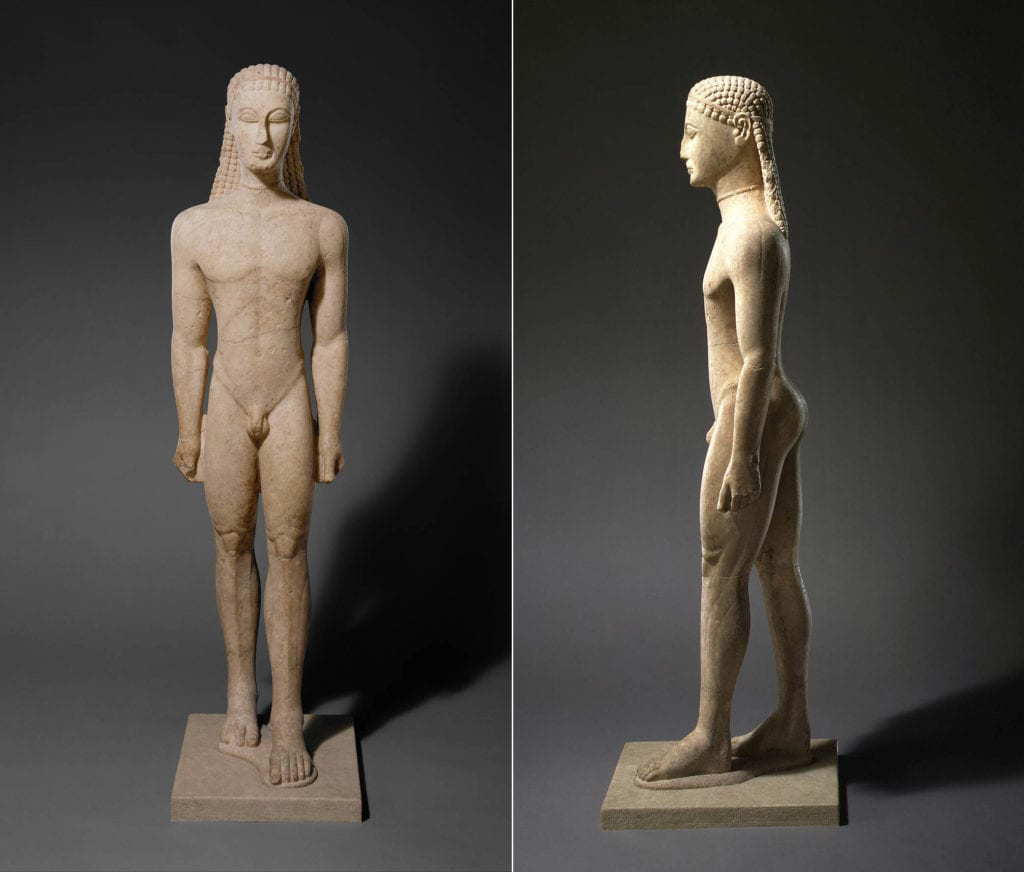
The Archaic Period of Ancient Greek fine art likewise saw dramatic innovation in sculpture production. These naturalized sculptures called kouroi appeared. Kouroi were commemorative, semi-lifelike statues representing idealized young men during their prime. Also existing was the less famous, clothed female person analogue: the kore.
Kouroi looked notably Egyptian; their slightly angular, geometric design mimicked that of ancient Egyptian statuary or wood sculpture. They stood upright with broad shoulders, artillery at their sides with slim hips and their legs together. However, throughout the Archaic Menstruation, they evolved into more naturalistic, detailed forms characteristic of the following Classical period.
Classical Flow, ca. 480-323 B.C.
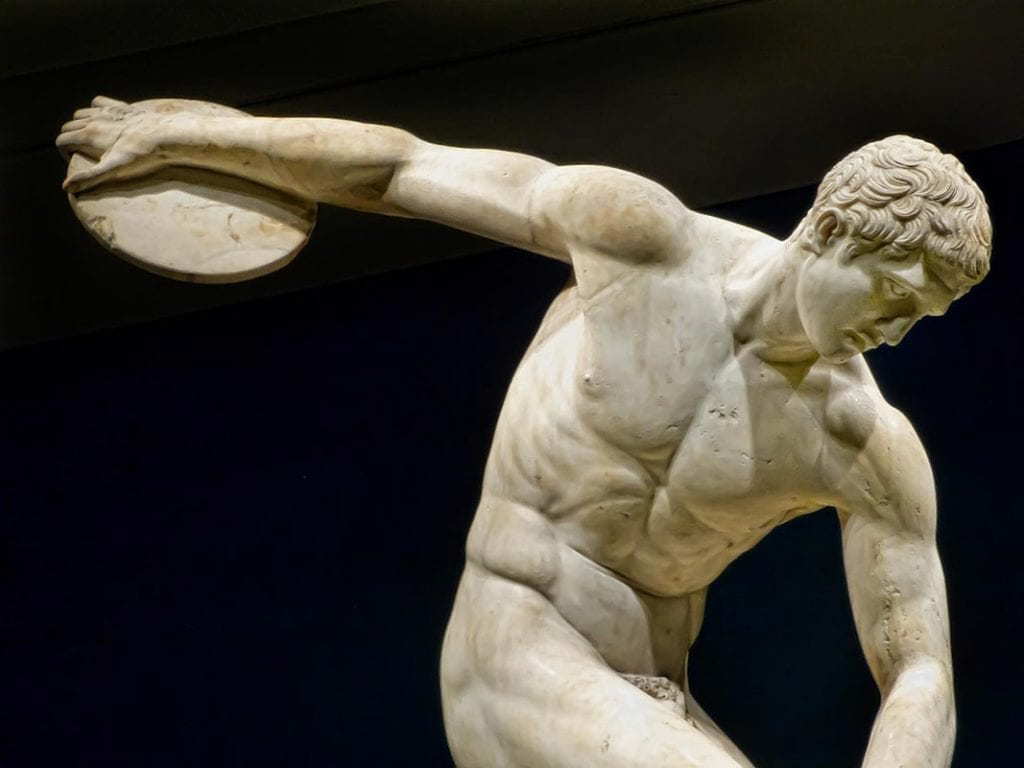
The Classical Period began with the cease of the Athenian tyranny in the fifth Century B.C., which paved the way for the subsequent institution of democracy. It also saw the Persian Wars and the rule and death of Alexander the Keen in 323 B.C. Philosophers such as Plato, Socrates and Aristotle came to fame during this period, and it has been regarded as an Athenian 'gilded historic period,' during which intellectualism, art, literature, and culture flourished.
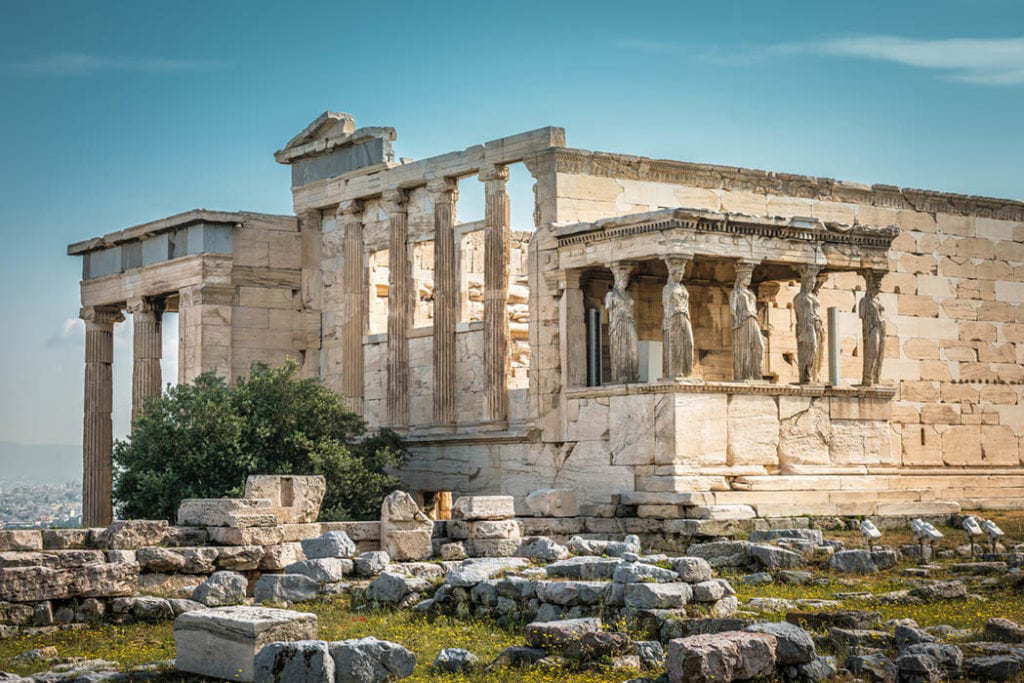
This period saw the introduction and expansion of many things that represent Ancient Greece to modern viewers, and one could not expect at the classical manner without considering its architecture. There was an increment in monumental temple construction during the Classical Period, which included the completion of the Athenian Acropolis and Erechtheion alongside numerous temples in locations including Delphi, Olympia, and Corinth.

At that place were three recognizable architectural styles during the Classical Period: the Doric Order, Ionic Guild and Corinthian Order. The Doric Club was uncomplicated, with plain pillars, capitals, and pediments. The Ionic Lodge was slightly more ornamented, with pillars that looked like a rolled curlicue. The Corinthian Order was the most detailed of the three, with intricate, organic pillar and uppercase designs.
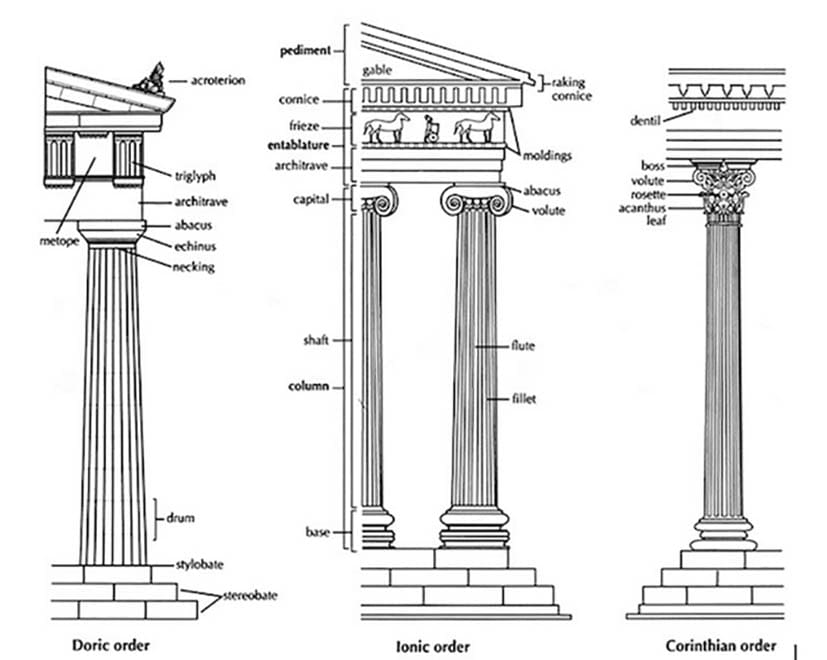
Classical art is also easily recognizable from its near-perfect depictions of the human grade in life-size and monumental sculpture. Greek artists became increasingly focused on the study of human anatomy and musculature, evolving from the Archaic kouroi to more naturalistic, physically accurate depictions of the human being form.
Aboriginal Greek sculpture also gained variation in field of study matter and body pose. Rather than depicting the archetypal idealized man or woman, Classical sculpture began to showroom a more diverse ready of recognizable features. Sculptors also experimented with the human form by crafting pieces with the field of study in action, or standing in the iconic contrapposto pose, with i hip protruding and the weight shifted to its side.

While the male nude was prioritized by most artists during this menses, Praxiteles experimented with the female nude, pioneering the female course in his sculpture of the Aphrodite of Knidos (ca. 350 B.C.). The sculpture became then famous that it remains, in modernity, as the 'archetypal female person nude', and is continually referenced in the report of the female person course. There was besides a rising presence in domestic reliefs which depicted women and family unit scenes.
Hellenistic Catamenia, ca. 323-31 B.C.

The Hellenistic Period in Ancient Greek art began with the death of Alexander the Great in 323 BC. The leadership of the massive empire that he had accrued throughout the Mediterranean, North Africa, and parts of Asia was afterward divided into three regions and assumed by generals, splintering the empire. All the same, Greek art continued to expand on the classical 'Hellenism' of the empire in fine art with more international influence.
Generally speaking, Hellenistic Period fine art featured an increase in expression and detail from the Classical Period. Information technology began to diverge from the idealization of the Classical Period, and artists were no longer restricted to describe physical perfection. They were free to explore themes of affliction, decease, and old age in sculpture.

Fifty-fifty with the fragmented empire after Alexander the Nifty's death, there was a large corporeality of privatized wealth within it. This resulted in a rising in private creative commissions and thus more variety in the subject matter. Pieces were produced for domestic enjoyment rather than just commemoration, which also meant that in that location were sometimes elements of comedy or irony.
In that location was as well significant innovation with mold making for the production of drinking vessels and votive terracotta figurines, which may business relationship for their increased importance and utilize during the Hellenistic Period. The miniature statues, oftentimes depicting women holding objects of religious significance, had previously been used for religious offerings. Withal, with their wider availability, they rose in popularity as funerary decoration also.

Though little physical evidence of Hellenistic Period painting survives, it is known for its rise in depictions of landscapes. Many of these landscapes combine realistic natural elements with religious themes. They were often also used as settings for recreations of myth or ancient literature. There is also a modest corporeality of prove of Hellenistic wall painting, more often than not seen in the Macedonian imperial tombs at Vergina, which feature mythical and religious elements too.
lockhartbriat1944.blogspot.com
Source: https://www.thecollector.com/ancient-greek-art-architecture/
0 Response to "The Classical Period of Greek Art Began Around"
Post a Comment